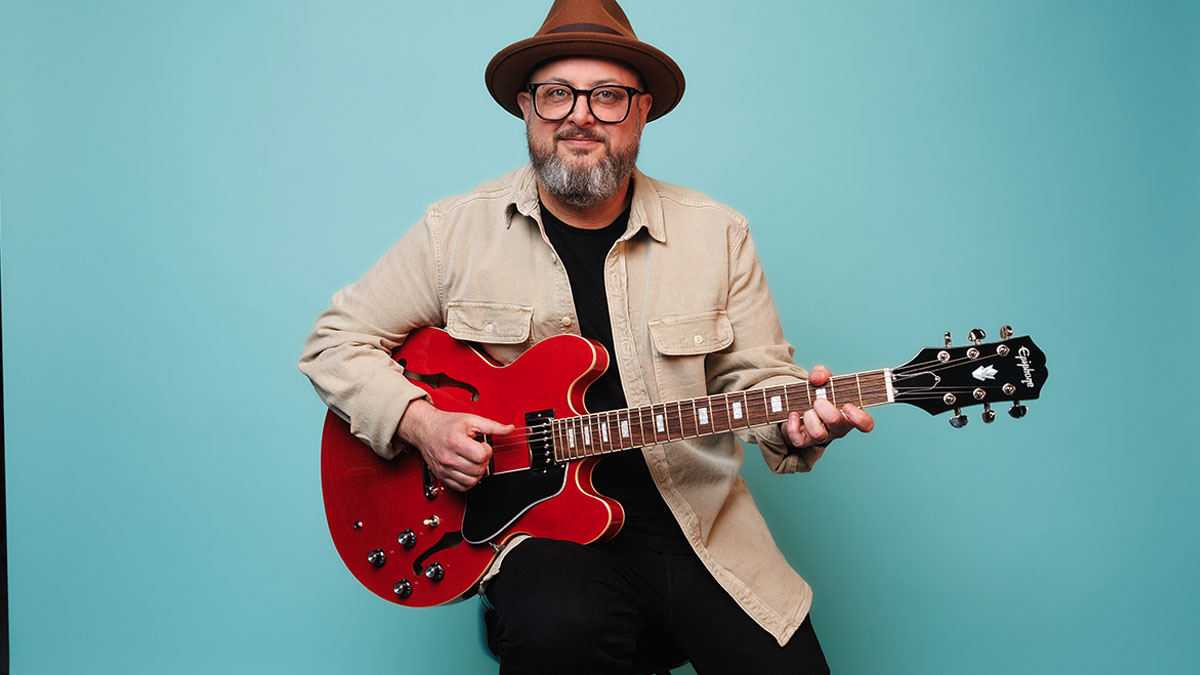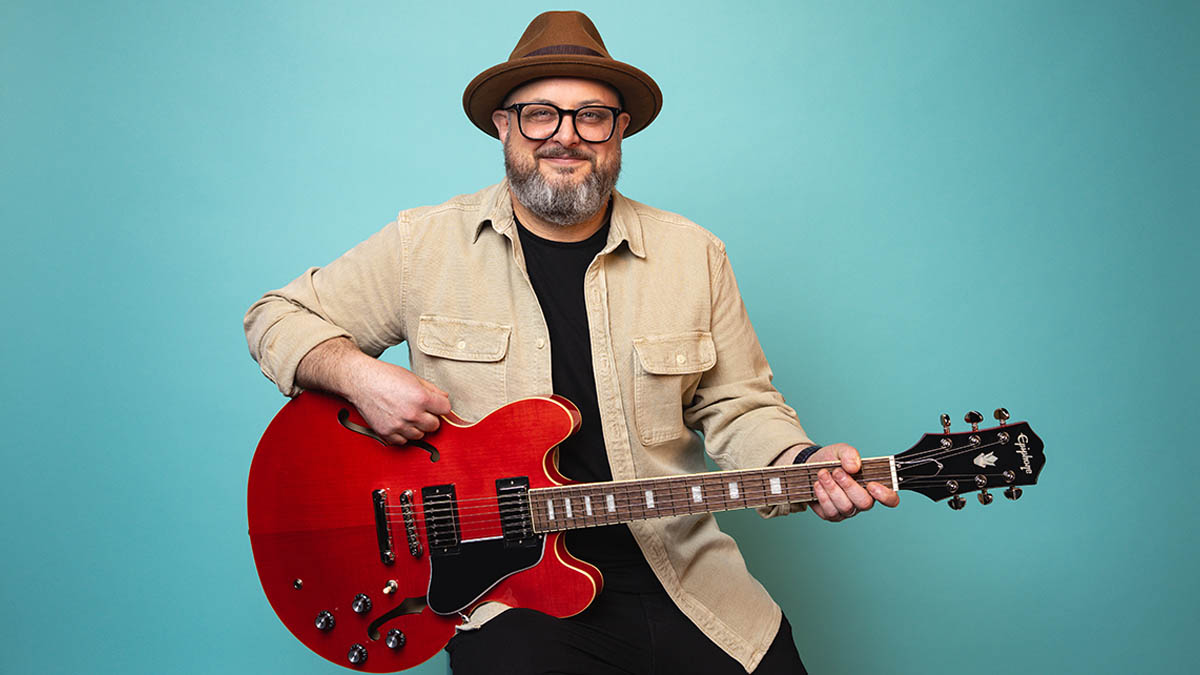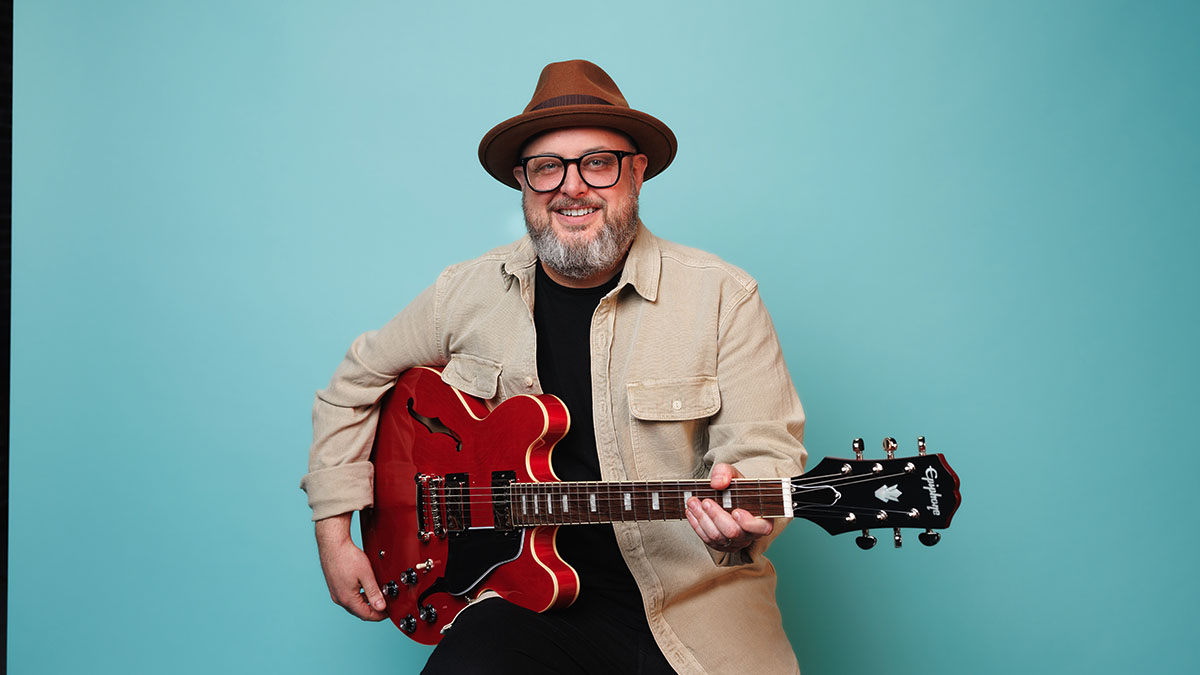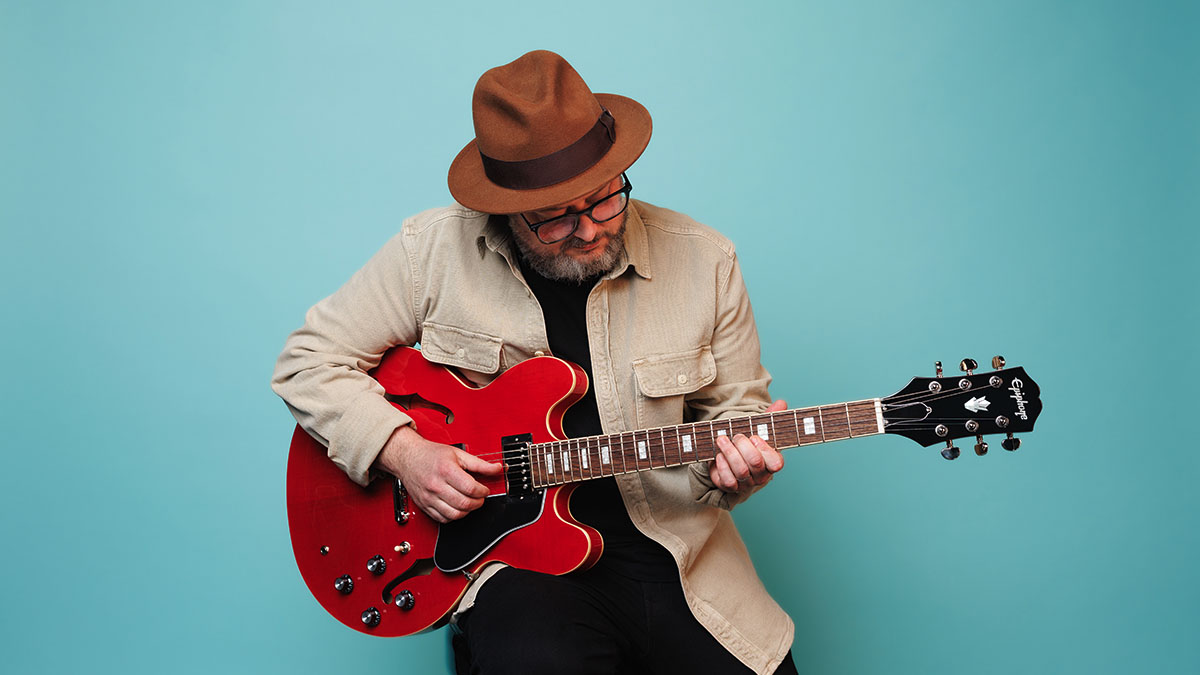“There is a lot of performance anxiety with students and their teacher... But with a video you can watch it a million times over. No one’s judging you”: Marty Schwartz on teaching guitar in the 21st century
The master teacher behind the Marty Music YouTube channel discusses personal tuition vs video, how tech is helping more people learn, and reveals the player he would want a lesson from

Should Marty Schwartz’s career continue in its current trajectory it might not be long before he can legitimately claim to have taught more people to play the guitar than the great Mel Bay.
Throughout history, guitar design hasn’t changed that much. Even after the most radical advancements in guitar making technology, the acoustic guitar is still recognisably an acoustic guitar. The electric guitar is still a miracle of 20th-century engineering, not 21st.
But how we learn the instrument has been transformed by technology, and online platforms allow über-teachers like Schwartz to reach players in all corners of the globe, 24 hours a day, seven days a week; and with over 3.89 million subscribers to his YouTube channel, Marty Music, that’s a lot of teaching.
Heck, he might already have overtaken Bay, whose Modern Guitar Method shifted upwards of 20 million copies and for generations has been the guitar’s very own Rosetta Stone. But with numbers like that, who’s keeping score?
Either way, Schwartz’s influence on contemporary guitar culture is huge, and it has not gone unnoticed, with Epiphone launching a signature Marty Schwartz ES-335 in his honour. It’s a guitar that is designed much like his teaching ethos – anything goes.
This is one of those do-anything signature guitars, but then the ES-335 has always been a Gibson design for all musical occasions. Looking the part in Sixties Cherry finish Schwartz’s signature model, and it’s one that’s priced and spec’d for the jobbing pro and the amateur looking for a step up from a beginner guitar.
“I have so many different styles of students,” says Schwartz. “I’ve got advanced people watching, but I’ve got a lot of beginners, so I just wanted the most accessible guitar for the most people, but also the nicest-playing guitar for the price point.”
Want all the hottest music and gear news, reviews, deals, features and more, direct to your inbox? Sign up here.
I just wanted the most accessible guitar for the most people, but also the nicest-playing guitar for the price point
You can read more about the Marty Schwartz ES-335 here, and check out the videos for how it sounds – with that push/pull phase switch offering some bonus sounds that broaden its musical potential. As Schwartz joins us here from Nashville, we’re going to be talking teaching, technology, and what this tells us about guitar culture today.
We live in an era of prodigious virtuosity displayed on social media, of TikTok shred, and of information overload. What does this mean for how we learn the guitar? Maybe no one can answer that but if anyone can, Marty Schwartz, 3.88 million students and counting, can.
There are so many different places where we can get guitar lessons, different sources of information. It can be bewildering. Are we in danger of missing out the fundamentals? Or is it simply a case of standards rising?
“Well, there are always the pros and cons of technology, and the way this stuff has evolved – there are way more pros just now. There is so much information. People tend to not have the step-by-step direction. They can just jump around and grab different things.
“But for anyone that’s really serious about it, and passionate about it, the information is out there. I think it depends on the various personalities of how to learn but I think someone that’s really serious about it will just find their way through it.”
For anyone that’s really serious about guitar, and passionate about it, the information is out there
What is great about your lessons is that, even as an experienced player, or especially as an experienced player who has learned bad habits over the years, there is always a corrective, remedial lesson. How do you choose what you want to teach and when?
“I have categories of videos, and that helps me. For instance, I’ve got technique videos, which are not song tutorials. I am always doing them. At least every Tuesday I am releasing a technique video, so then that goes up on my to-do list, ‘Okay, on Tuesday, it’s always a technique video.’ Yesterday, I shot two different technique videos, and I have maybe three that are already in the can.
“I am trying to stay two weeks ahead of my release schedule, and that helps actually with not feeling the pressure of, ‘Oh God! What am I doing tomorrow?’ Which I do sympathise with some types of content creators who have to come up with an original idea every video, whereas I have these different categories. I mean, I have taught thousands of songs, but there is always another song. At least so far. If I run out of songs then I may just retire.”
That’s one thing you can’t run out of.
“Or, another thing I have done because of that, is a new series called Riff Theory, so that comes out on Sundays, and since I’ve taught the biggest 100 riffs already in my career, I am kind of going through them now and pointing out what scale it is, what the theory is, and digging in to understand why it is a classic riff instead of just teaching it, so that gives me a whole new pool of ideas.
“And then there is always classic lessons, which I can then go, okay, ‘90s lessons are really popular now – they really are. I can just go look at, ‘Gosh, what haven’t I done yet?’ And so that’s another category. Then on Saturdays I do a livestream. Different categories help organise what I am doing, and then I will try stay ahead of my release schedule, which means if I have a day where I am doing stuff like this, doing an interview and not shooting a video, then I can make up for it along the way.”
I have taught one-on-one-guitar lessons for over 10 years, before the internet or YouTube and all that, and there is a lot of performance anxiety with students and their teacher
With all these digital platforms, is there still a place for face-to-face instruction – and what are the benefits, and what should people look for in their guitar teacher?
“Yes. I always say, and this is related to your earlier question, I didn’t have the benefit of my own videos when I was learning, but the other side of that – and I spent money on college tuition, and my parents spent money on guitar tuition – is I always had these great guitar mentors who inspired me one on one, and they could give me real-time feedback and goals to reach, and all these different things that were catered to me.
“Nothing’s ever going to be better than that but I love what’s happened with YouTube and that I can do what I do, and with some people they have the supplement for guitar lessons but for most people they are just watching the videos for fun and learning guitar along the way. Nothing is better than a good private guitar teacher.

“The other side of that, with my videos and just YouTube in general, and I have noticed this a lot because I have taught one-on-one-guitar lessons for over 10 years, before the internet or YouTube and all that, and there is a lot of performance anxiety with students and their teacher, maybe because they were busy that week and they didn’t practice – especially kids. There’s anxiety involved with the teachers watching and judging them. There is this other element that makes them a little more intimidated.
“Not with me! Because I did my best to make things fun, and I would get to know them. But with a video you can stop it and pause it and watch it a million times over. No one’s judging you. You can sound bad. ‘Oh my God! I’m not doing it well!’ But no one is sitting there judging you, ‘Oh, time is ticking!’
if I had a really good guitar teacher, I could see him next lesson and say, ‘Here’s that thing I learned on YouTube!’ And the teacher can be like, ‘That’s awesome’
“Having a great mentor in anything – not just guitar lessons – is always going to be better than video instruction but I know if I was coming up and learning right now, and I had a really good guitar teacher, of course I would have him be my mentor, be someone I really looked up to, then I would go home and watch YouTube videos and add more knowledge.
“And if I had a really good guitar teacher, I could see him next lesson and say, ‘Here’s that thing I learned on YouTube!’ And the teacher can be like, ‘That’s awesome.’ Or, ‘I see what he’s doing. Here’s how I think of that.’ That sort of thing.”
Sure, maybe both is best. Because that performance anxiety is real. But even that can also be helpful, too, because it teaches you to play in the company of others, to be in the habits of playing with people. Do you ever get these nagging concerns with your own playing? What aspect of your playing keeps you awake at night?
“Oh, man! I have been spending a lot of time in Nashville for the past 10 years now, and I am in Nashville right now. That’s where Gibson is. And also the company that manages my YouTube channel is in Nashville. So being here, and being surrounded by the best guitar players – at least per capita – and to have them embrace me just as a peer, and to sit in with various bands, with Jared James Nichols, with Guthrie Trapp – those two guys are just incredible. And they are just so cool.
I am not virtuoso style. That has never been my style. But knowing I can go up and sit in with someone who is a virtuoso, like Guthrie Trapp has really boosted my confidence
“I’ve sat in with all these great different players, and that has has really been, more than anything, inspiring, and since I get to do this for a living I have a guitar in my hand everyday, so I really feel like, between just loving to play and playing everyday for myself, and then also still being inspired to do the content, I have never loved guitar more, and it has rewarded me beyond my wildest dreams. I am playing a ton now, just for myself, and being around these guys is just a huge motivator, and it’s like osmosis. You notice. You listen.
“I am not virtuoso style. That has never been my style. But knowing I can go up and sit in with someone who is a virtuoso, like Guthrie Trapp, and have it totally be organic and not feel like I’m being outshined, and we’re vibing and everything, that has really boosted my confidence. And also, when I was in my 20s I had to be better than anyone I saw and now, in my 40s, I can finally appreciate different talents that different people have and think, ‘Yeah, I don’t have to live up to that.’”
That’s the thing, isn’t it. That’s where you’re getting somewhere, when you don’t find yourself looking at others and stop comparing. There is always going to be someone you think is better so…
“Nashville is really good for me in that way because you have to accept that you are definitely not going to be the best.”
There’s something healthy about that, and about just enjoying the journey and taking pleasure in playing no matter your level.
“Gosh, it was about eight years ago I started a whole new brand for myself and completely started over, and when I had to do that, and I had nothing, zero subscribers, and there was no guarantee I was going to come back successful with Marty Music, but when I had to do it and it was very difficult.
“On day one, I had to really, really remind myself in my head, ‘Enjoy the journey.’ And then I blink, it’s eight years later, and it’s exceeded all my expectations. But this is the stuff I reminded myself all those years back; this is the stuff you are going to appreciate the most in getting where you are right now.”

What sort of things are people wanting to learn? What are the trends now? Are people’s tastes noticeably changing?
“Yeah! I remember when Bruno Mars first hit the mainstream. I think it was right when my channel was starting, like 15 years ago, so I remember teaching all his acoustic ballads, I’ll Remember You. Right now, I think about Silk Sonic, and all these amazing things he does, but I remember all his easy [songs] – ‘Call on me, 1, 2, 3 and I’ll be there’ – these real easy acoustic love songs, three or four of them right at the beginning of my YouTube channel.
“I remember those being huge for the channel, and I remember the early Jason Mraz song – it’s the same chord progression. It was around 2008 when I started. The songs could have come out a couple of years earlier. Jack Johnson, and some of those easy acoustic songs right at the beginning of my YouTube channel were huge, and if I did one of those now it wouldn’t get nothing! Nothing Else Matters is the most popular song.”
Nothing Else Matters? Still? It is rewarding to play, and deceptively difficult. Kirk Hammett even flubbed it.
“I was so grateful for that! I loved it. I loved it.”
How do you look at AI. How will it affect guitar teaching? How will it affect you?
“I think that no one is going to be able to stop it. I just have to embrace it. Embrace it right away. I don’t even know what that means except to not fight against it because it will be a losing battle.You could say why has YouTube hurt the guitar [teaching] business? Because guitar teachers don’t have as many students because demand is lower because they could just watch it for free.
“But the other side of it is that, if you go take a guitar lesson, it has never been easier for a guitar teacher to learn a song to teach because of it – and I have heard some guitar teachers say both sides.”
AI could give us the tab and the chord chart but it can’t give us the human voice and the personality of someone like yourself, or our private guitar tutor, to explain to the player the bit that’s tripping them up.
“Yeah, I’ll tell you, the AI technology that I am using with almost all of my song lessons these days is related to the technology they used for the Beatles documentary, where they were able to isolate each instrument. It is an AI technology that does it; it’s not the same as ChatGPT talking to you or whatever, but it is based on an AI engine, and it is an app that I’m using called Moises.
“You have to buy or download the song off iTunes, or own an audio file to do it, so I’ll be it for $1.29 off iTunes, download it, and put it into Moises, and it will isolate each instrument, then I’ll remix it. I’ll turn everything but the guitar track down three-quarters. I still like having everything in there but I’ll have it where the guitars are way boosted in the mix and you can just hear it better.
I learn quickest by ear, with other supplements, like looking up on a video what hand position he is in
“I learn quickest by ear, with other supplements, like looking up on a video what hand position he is in. ‘Oh, is he in an alternate picking? Let me start investigating.’ The video is not out yet but I just did This Charming Man, by The Smiths. I used Moises. It has pitch correct.
“What I discovered was he tuned the guitar up, and it sounds almost a whole step up, and when you look at footage he doesn’t have a capo, so the most correct and easy way to teach it would be with the capo on the second fret because you are not going to be damaging your guitar and messing it up for the other tunings you want to play – but that’s not how Johnny Marr played it so you’ve got to do it like Johnny Marr did it.
“I put on the lightest strings possible on a Tele and I tuned it up a whole step, and it really just barely worked. The action was really high, and I just didn’t feel like that was what he was doing, but when I did it by ear, it wasn’t quite a whole step. It was just enough to take a little bit of the tension off, then I rethought, ‘Well I guess he is doing this.’
“And with [reel-to-reel] tape it could have been sped up a little bit, so he might have been up a half-step and the tape made him go higher. But yeah, that was something I had never done before, and it was only a couple of weeks ago. I am grateful for this job because I would have never learned This Charming Man.”

If you had the chance of one lesson, and one lesson to learn, who would you want to teach you and what would you want to learn?
“Gosh, you are probably making me think this into reality but it’s probably John Scofield, and just like some cool wisdom and some of that bluesy be-bop, because I have no desire to be like John Coltrane and play Giant Steps or anything like that – which John Scofield can do masterfully – but he can also just groove over a minor-seventh chord and play this funky be-bop vocabulary that I am always exploring.
“And we have mutual friends and stuff; you’ve made me think it into reality now. Yeah, that would probably have to be it. I have learned from watching Larry Carlton, and he lives, I think in Tennessee here, so that’s another one that might be possible. But I am also at a level where I can actually learn by watching them and listening to them.”
You hear Scofield and Larry Carlton and they have got that chromaticism and this really sophisticated harmony but still within that realm of being really approachable for your ear
And you can now talk ES-335s with Larry now you have your signature model…
“Yeah, that’s right! No, he is Mr ES-335. But when you hear Larry Carlton and John Scofield, they are not so far from each other – there is a sophistication but it’s always bluesy, like Carlton’s solos on Steely Dan.
“As a guitar player, I play all this mainstream music so I am quite well equipped in the blues and minor pentatonic, the basic modes and stuff. You hear Scofield and Larry Carlton and they have got that chromaticism and this really sophisticated harmony but still within that realm of being really approachable for your ear. I am always exploring that for myself, really. Just for my own, I guess.”
- Let Marty Schwartz teach you all things guitar at Marty Music on YouTube
- For more on the Marty Schwartz ES-335, head over to Epiphone.
Jonathan Horsley has been writing about guitars and guitar culture since 2005, playing them since 1990, and regularly contributes to MusicRadar, Total Guitar and Guitar World. He uses Jazz III nylon picks, 10s during the week, 9s at the weekend, and shamefully still struggles with rhythm figure one of Van Halen’s Panama.
